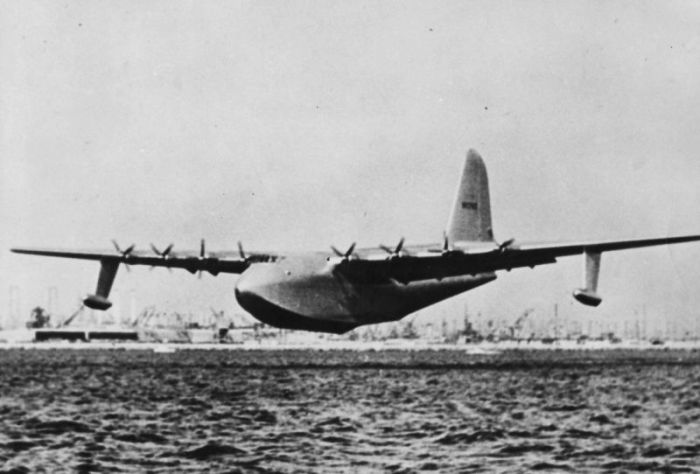|
|
History: Spruce Goose, Hughes H-4 Hercules
|
The aircraft was the brainchild of Henry J. Kaiser, a leading Liberty ship builder. He teamed with aircraft designer Howard Hughes to create what would become the largest aircraft built at that time. It was designed to be capable of carrying 750 fully equipped troops or one M4 Sherman tank. The original designation "HK-1" reflected the Hughes and Kaiser collaboration.
The HK-1 contract was issued in 1942 as a development contract and called for three aircraft to be constructed under a two-year deadline in order to be available for the war effort. Seven configurations were considered including twin-hull and single-hull designs with combinations of four, six, and eight wing-mounted engines. The final design chosen was a behemoth, eclipsing any large transport then built. To conserve metal, it would be built mostly of wood (its elevators and rudder were fabric covered); hence, the "Spruce Goose" moniker tagged on the aircraft by the media. It was also referred to as the Flying Lumberyard by critics. Hughes himself detested the nickname "Spruce Goose".
While Kaiser had originated the "flying cargo ship" concept, he did not have an aeronautical background and deferred to Hughes and his designer, Glenn Odekirk. Development dragged on, which frustrated Kaiser, who blamed delays partly on restrictions placed for the acquisition of strategic materials such as aluminum, but also placed part of the blame on Hughes' insistence on "perfection." Although construction of the first HK-1 took place 16 months after the receipt of the development contract, Kaiser withdrew from the project.
Hughes continued the program on his own under the designation "H-4 Hercules", signing a new government contract that now limited production to one example. Work proceeded slowly, with the result that the H-4 was not completed until well after the war was over. It was built by the Hughes Aircraft Company at Hughes Airport, location of present day Playa del Rey, Los Angeles, California, employing the plywood-and-resin "Duramold" process – a form of composite technology – for the laminated wood construction, which was considered a technological tour de force. It was shipped on streets to Pier E in Long Beach, California by a company specializing in house moving. The Spruce Goose was moved in three large sections consisting of the fuselage and each wing, and a fourth smaller shipment containing the tail assembly parts and other smaller assemblies. After final assembly a hangar was erected around the flying boat with a ramp to launch the H-4 into the harbor. This building became the first climate-controlled building in the United States.
|
|









